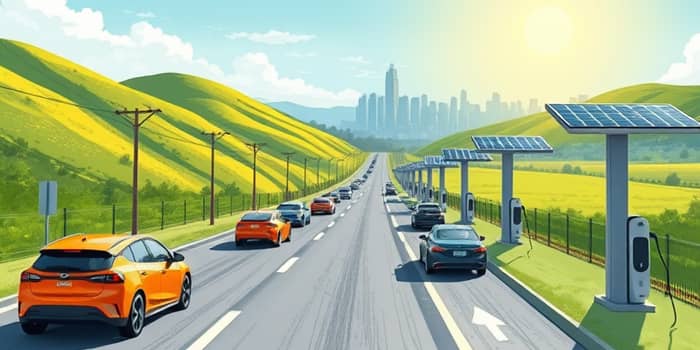
In recent years, the automotive industry has undergone a profound transformation as electric vehicles (EVs) shift from niche curiosities to mainstream mobility solutions. This revolution is fueled by breakthroughs in technology and a wave of supportive policies that are reshaping global transportation.
The pace of adoption has never been faster, and the road ahead promises even greater momentum as nations rally to meet environmental goals and foster economic growth.
Global EV and plug-in hybrid sales are projected to reach nearly 22 million units in 2025, marking a dramatic year-over-year growth rates compared to 2024. This follows an astonishing 35% surge between 2022 and 2023, underscoring a market in full acceleration.
In the first quarter of 2025 alone, more than 4 million electric cars found new homes worldwide—a 35% increase compared to the same period in 2024. Analysts now anticipate that one in four vehicles sold globally this year will be electric, a milestone that would have seemed impossible just a decade ago.
The global electric car fleet hit approximately 40 million vehicles by the end of 2023, and that number continues to climb. With forecasts suggesting 17 million new EV sales in 2024—about 20% of all new car sales—stakeholders are paying close attention to charging infrastructure, battery innovation, and policy shifts that will sustain this upward trend.
While this is a global phenomenon, the speed and scale of EV adoption vary dramatically by region. Three epicenters of growth—China, Europe, and the United States—offer contrasting stories of policy, consumer behavior, and market structure.
China’s success is underpinned by robust local manufacturing, aggressive purchase subsidies, and widespread infrastructure deployment. European nations combine stringent emissions regulations with purchase tax credits to motivate buyers, while many U.S. states supplement federal incentives with their own grants and rebates.
Despite these efforts, policy rollbacks at the federal level in the U.S. have slowed momentum, highlighting the delicate balance between political will and market growth.
The rapid expansion of electric mobility is driven by a convergence of factors that reinforce each other in a virtuous cycle of growth.
Many governments also waive tolls, offer free parking, and exempt EVs from registration taxes, creating additional incentives that extend beyond simple purchase rebates. Meanwhile, private firms and utilities are racing to install fast chargers and battery swap stations along highways and in urban centers.
This expanding ecosystem not only supports current EV drivers but also sends a clear signal to automakers and investors that electrification is the future of mobility.
Electrification is not limited to personal vehicles. Expanding electrified transportation landscape spans buses, two- and three-wheelers, and even commercial fleets.
In cities across Asia, electric scooters and motorbikes are becoming the norm, driven by low-cost ownership and reduced urban emissions. Public transit authorities are deploying electric buses on major routes, cutting noise and air pollution in densely populated areas.
Fleet operators—from delivery vans to ride-sharing services—are adopting EVs to reduce operating costs and meet corporate sustainability targets. The combined effect is a transportation network that is cleaner, quieter, and more efficient.
Despite the impressive momentum, several hurdles remain before EVs can fully supplant traditional vehicles.
Moreover, concerns over battery end-of-life recycling and the environmental impact of raw material extraction require ongoing attention. Governments and industry must collaborate on sustainable mining practices, circular economy initiatives, and strict recycling standards to maintain public trust.
Consumer education is also vital. Many potential buyers remain uncertain about total cost of ownership, charging logistics, and long-term reliability of electric vehicles.
Electric vehicles are central to global strategies aimed at achieving ambitious zero-emission targets by 2050. Transportation accounts for nearly a quarter of global greenhouse gas emissions, and EVs represent one of the most effective levers for change.
Governments worldwide have committed billions to support electrification, from building charging infrastructure to funding research into next-generation batteries and green hydrogen solutions. The collective push is not only about cleaner air but also about energy security, reduced oil dependency, and the creation of a sustainable auto industry.
For consumers, businesses, and policymakers alike, the message is clear: the electric transition is unstoppable. Each new purchase, each charging station installed, and each policy enacted brings us closer to a healthier planet and a more resilient economy.
As the wheels of change continue to turn, the electric vehicle revolution offers an inspiring example of how innovation, policy, and public will can unite to tackle one of humanity’s greatest challenges.
References













